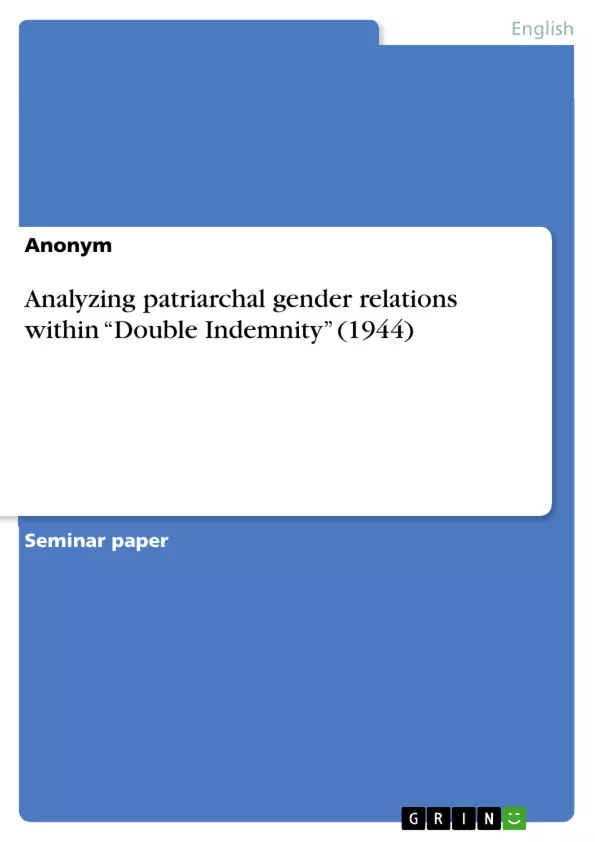In the course of my paper, I explore how Billy Wilder's film “Double Indemnity” (1944) depicts patriarchal gender relations and why Phyllis Dietrichson’s character is socially relevant and a testament to those patriarchal structures of her time.
I will start by establishing the concept of Patriarchy in chapter 2. The chapter is important to clarify basic ideas that emerged from gender studies and lay a foundation. Chapter 3 introduces the femme fatale as a female archetype in Film noir. Here, I will point out what characterizes the showpiece-femme fatale, with reference to the socio-cultural background. The following Chapter is the main focus of my paper: The analysis of Phyllis Dietrichson in “Double Indemnity” (1944). After a short introduction to her character, I will examine Phyllis in relation to men. This is pivotal for the success of this paper.
How is she affected by patriarchal gender relations and why is her womanhood threatening to men? And since we are dealing with a filmy analysis, how is this cinematically staged? Chapter 5 will concentrate on the relationship between Walter Neff and Barton Keyes. I decided to add this chapter because their male-male bond reinforces patriarchal ideas and is a perfect contrast to the relationships of Phyllis with Walter and her husband. By tradition, the conclusion is the finishing part of my paper.
Inhaltsverzeichnis (Table of Contents)
- Introduction
- Establishing the concept of Patriarchy
- The femme fatale as a female archetype in Film Noir
- Characteristics
- The femme fatale in relation to men
- Socio-cultural background
- Analysis of Phyllis Dietrichson in Double Indemnity (1944)
- A typical femme fatale in the Noir sense
- Phyllis in relation to men
- Relationship with husband and family
- Relationship with Walter
- Male relationships as a patriarchal safe haven: Walter and Barton
- Conclusion
Zielsetzung und Themenschwerpunkte (Objectives and Key Themes)
This research paper explores the portrayal of patriarchal gender relations in the film "Double Indemnity" (1944) and aims to analyze why Phyllis Dietrichson's character is so significant in initiating a critical, gender-based discussion. The paper delves into the concept of patriarchy, examines the femme fatale as a female archetype in Film Noir, and analyzes Phyllis Dietrichson's character within the context of patriarchal structures.
- Patriarchal gender relations in Film Noir
- The role of the femme fatale as a symbol of male anxieties
- The impact of patriarchal structures on female characters
- The relationship between gender stereotypes and societal expectations
- The significance of male-male relationships in reinforcing patriarchal ideas
Zusammenfassung der Kapitel (Chapter Summaries)
- Introduction: This chapter introduces the concept of Film Noir's portrayal of gender relations and establishes the significance of analyzing patriarchal structures within the context of the film "Double Indemnity" (1944). It focuses on the importance of the femme fatale as a female archetype in Film Noir, particularly the character of Phyllis Dietrichson, who challenges patriarchal gender stereotypes.
- Establishing the concept of Patriarchy: This chapter provides a theoretical framework for understanding patriarchy as a system of social structures and practices that dominate, suppress, and exploit women. It explores various feminist perspectives on patriarchy and its impact on gender roles, stereotypes, and institutions like the family.
- The femme fatale as a female archetype in Film Noir: This chapter delves into the characteristics of the femme fatale as a female archetype in Film Noir, including her seductive nature, her ability to manipulate men, and her association with danger and destruction. It explores the socio-cultural background that contributed to the emergence of the femme fatale as a symbol of male anxieties.
- Analysis of Phyllis Dietrichson in Double Indemnity (1944): This chapter focuses on the character of Phyllis Dietrichson in "Double Indemnity" (1944) as a typical femme fatale in the Noir sense. It examines her relationship with men, particularly her husband and Walter Neff, highlighting the ways in which she challenges patriarchal gender stereotypes and confronts the limitations imposed on women by patriarchal structures.
- Male relationships as a patriarchal safe haven: Walter and Barton: This chapter explores the relationship between Walter Neff and Barton Keyes, highlighting how their male-male bond reinforces patriarchal ideas and contrasts with the relationships Phyllis has with Walter and her husband. It analyzes how this relationship serves as a patriarchal safe haven, further emphasizing the prevalence of patriarchal structures within the film.
Schlüsselwörter (Keywords)
This research paper focuses on the analysis of patriarchal gender relations in the film "Double Indemnity" (1944) with a particular focus on the character of Phyllis Dietrichson. Key themes include: Film Noir, femme fatale, patriarchal structures, gender stereotypes, male anxieties, female agency, and the impact of societal expectations on female characters. The paper explores the relationship between gender roles, power dynamics, and the portrayal of women in the context of a patriarchal society.
- Quote paper
- Anonym (Author), 2012, Analyzing patriarchal gender relations within “Double Indemnity” (1944), Munich, GRIN Verlag, https://www.grin.com/document/320220



